Editorial from the Series of Articles: Omnichannel Pharma Marketing
In recent years, omnichannel pharma marketing has become one of the most crucial developments in the pharmaceutical market. Therefore, in this series of articles, you will learn everything you need to know about omnichannel pharma marketing:
1. What is Omnichannel Pharma Marketing?
2. Why is Omnichannel Pharma Marketing so relevant for pharmaceutical companies right now?
3. How does Omnichannel Pharma Marketing work?
Part 1: Customer Journey in Omnichannel Pharma Marketing
Part 2: Channels in Omnichannel Pharma Marketing
Part 3: Data Management in Omnichannel Pharma Marketing
4. The Advantages of Omnichannel Pharma Marketing
5. What Impact does Omnichannel Pharma Marketing have on the Success of Pharmaceutical Companies?
+ Whitepaper: Implementation of Omnichannel Pharma Marketing
What is Omnichannel Pharma Marketing?
Omnichannel pharma marketing stands as one of the absolute top trends in the pharma market. According to a survey we conducted with sales and marketing experts, 80 percent rated omnichannel marketing as "relevant" to "very relevant" for the next five years. Additionally, 41 percent named omnichannel marketing solutions as their most important sales wish for the future, surpassing digitization at 24 percent and better customer information at 18 percent.
But what exactly does the "buzzword" omnichannel pharma marketing truly entail? This series of articles will delve into this topic.
Definition of Omnichannel Pharma Marketing:
Omnichannel Pharma Marketing is a communications approach for pharmaceutical companies that aims to link all of the company's sales and marketing channels around the needs of physicians and medical decision-makers. The main goal is to reach physicians – at the right time, through the right channel – with relevant content to accompany them through their decision-making process.
To achieve this, the omnichannel approach in pharma marketing combines three main principles:

1. Customer Centricity in Omnichannel Pharma Marketing
The primary principle in omnichannel pharma marketing is a clear emphasis on the needs and interests of doctors and other medical audiences. The aim is to align all sales and marketing efforts with the needs of the specific target group, both in the overall sales process and at each individual touchpoint. While this may sound simple, customer centricity requires a fundamental change in the way many pharmaceutical companies think. Employees throughout the company must learn to adopt the perspective of physicians and medical decision-makers. All communication should aim to make the target group feel supported at every stage of their decision-making process. Instead of merely focusing on their own products, solutions, and interests, pharmaceutical companies should understand the challenges, needs, and issues that are most relevant to each physician at any given moment. Needs-based communication in omnichannel pharma marketing is designed to offer clear added value to the target group with every interaction, ultimately increasing physicians' commitment and trust in the long run.
In the context of customer centricity, it is also essential to assess which channels need to be used to best reach physicians. For example, in younger physicians, their digital affinity plays a key role in choosing suitable channels for communication (See below: Trend generational shift).

2. Customer Journey in Omnichannel Pharma Marketing
Despite the name "Omnichannel Marketing" possibly appearing misleading, omnichannel pharma marketing is an approach that specifically links marketing and sales channels. The goal is to connect all points of contact with the physician to form a customer journey. The customer journey maps the various phases that a physician goes through in the decision-making process. While the initial focus may be on attracting the attention of the target group, in later phases, the focus lies increasingly on informing physicians about specific products and therapies, as well as strengthening their trust in your solutions. Unlike multichannel marketing, omnichannel pharma marketing is not solely about addressing the target group via different channels. It is equally crucial for the omnichannel approach to coordinate individual actions during the customer journey effectively and ensure strategic alignment between sales and marketing. This creates a personalized "journey" for every physician that conveys clear core messages across all touchpoints to engage them consistently at different stages of their decision-making process, regardless of the communication channel used (e.g., email, website, webinars, field sales visits).
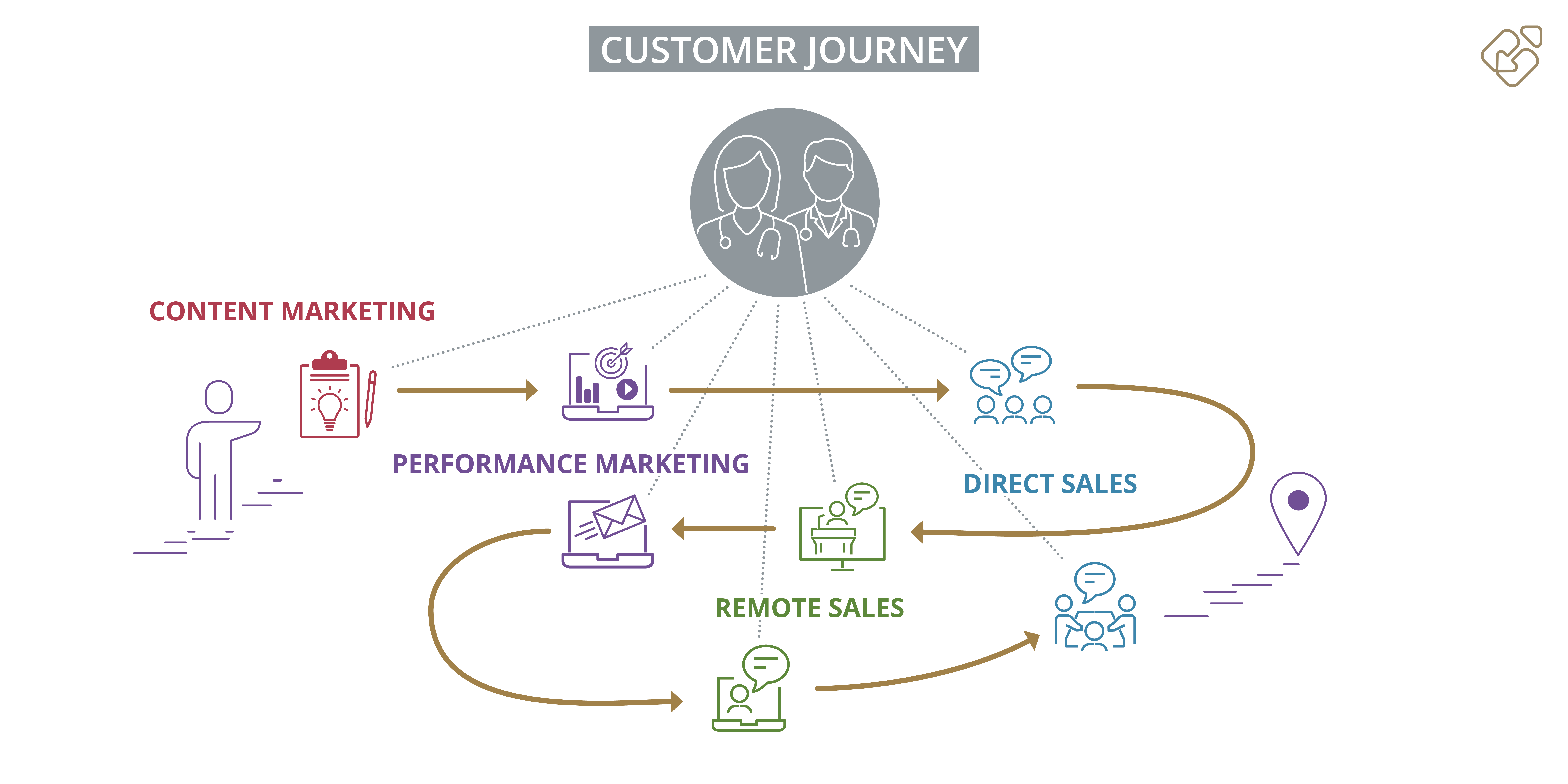
3. Customer Insights in Omnichannel Pharma Marketing
The basis for both the customer journey and customer centricity lies in a profound understanding of your own target group. Listening therefore plays a decisive role in omnichannel pharma marketing. Marketing and sales should not be a one-way street that bombards physicians with information across as many channels as possible. Instead, it's about developing a dialogue that equally values getting to know physicians' preferences, needs, and challenges. Therefore, relevant information and data should be systematically collected and analyzed across all channels. This applies to feedback from face-to-face contacts, as well as performance data on digital channels. Customer insights in omnichannel pharma marketing are derived from qualitative inputs (e.g., information gathered in sales conversations), quantitative data (e.g., emails read or campaigns clicked), as well as digital interactions (e.g., participation in webinars or visits to the company website).
In omnichannel pharma marketing, companies set up feedback and tracking processes for each channel to determine what data to collect and record and how. They create hypotheses for sales and marketing activities and use the collected data to assess their effectiveness. The objective is to improve the ability to measure interactions with physicians, allowing companies to continually refine their communication based on customer insights about their target audience's needs.
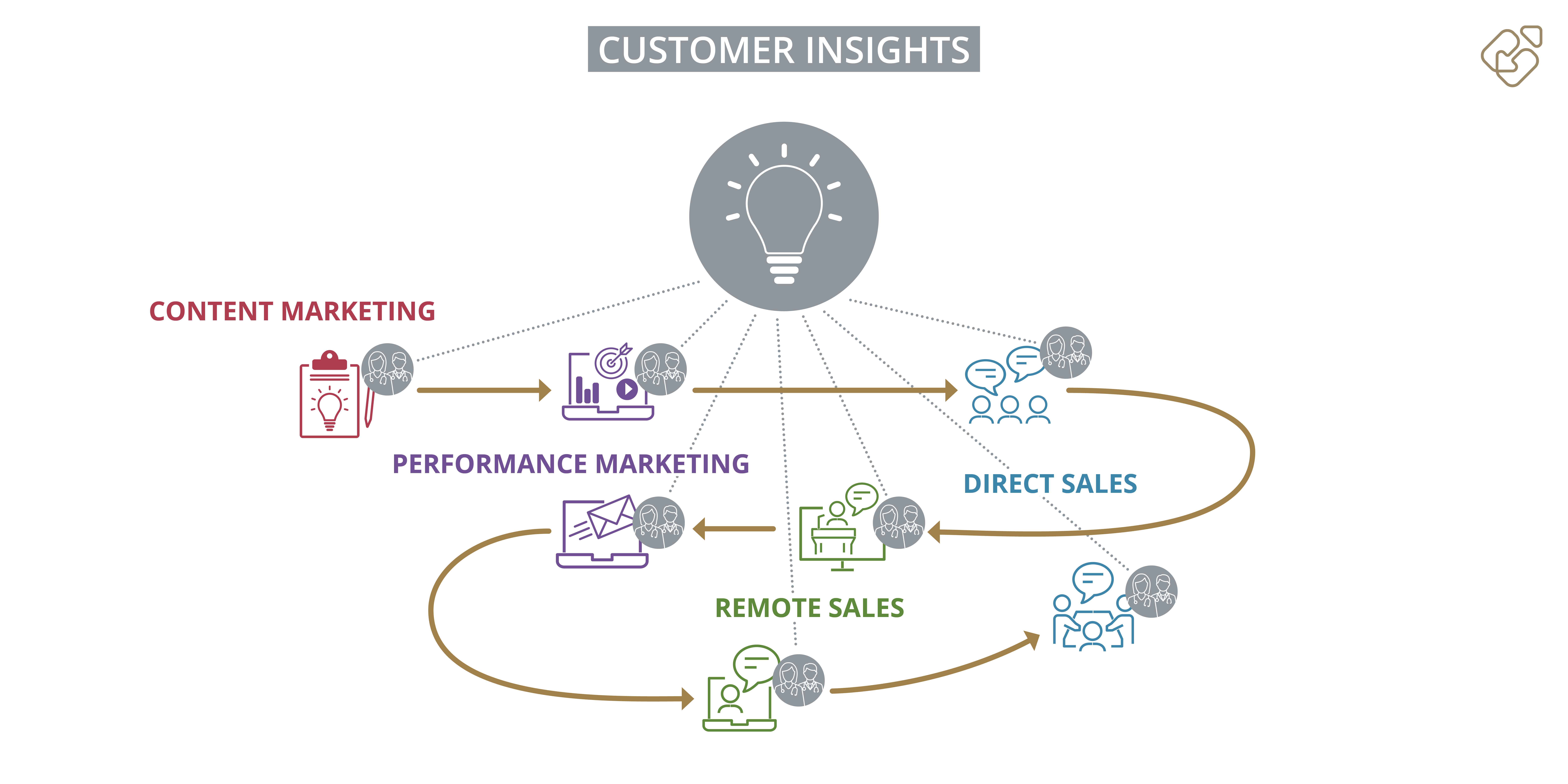
Only when all three principles above are combined, can omnichannel pharma marketing reach its full potential. This happens when companies simultaneously adapt their communication to the specific needs of physicians, connect their sales and marketing channels into a coherent customer journey, and begin to systematically collect insights on their target group. The overall goal of these three principles is to support each other. For example, customer insights help to better understand which topics and challenges are most relevant for physicians in their current decision-making phase, optimizing the customer journey and tailoring it to medical decision-makers. In addition, this strengthens customer centricity and the exchange with physicians, leading to the collection of new, more profound insights on them. When correctly implemented, the three basic principles of omnichannel pharma marketing thus form a mutually reinforcing cycle.

FREE WHITEPAPER
How to Implement Omnichannel Pharma Marketing in Practice?
- 5 Steps to Success - OCM Implementation Roadmap
- 5 Best Practices in Successful OCM Implementation
- 3 Success Factors that make the Difference in Practice
Why is Omnichannel Pharma Marketing so Relevant for Pharmaceutical Companies right now?
Like many other industries, the pharmaceutical market is undergoing substantial changes. Four developments, in particular, play a decisive role in this process and significantly influence future success in pharmaceutical marketing and sales.
The 4 Most Important Trends in the Pharma Market:
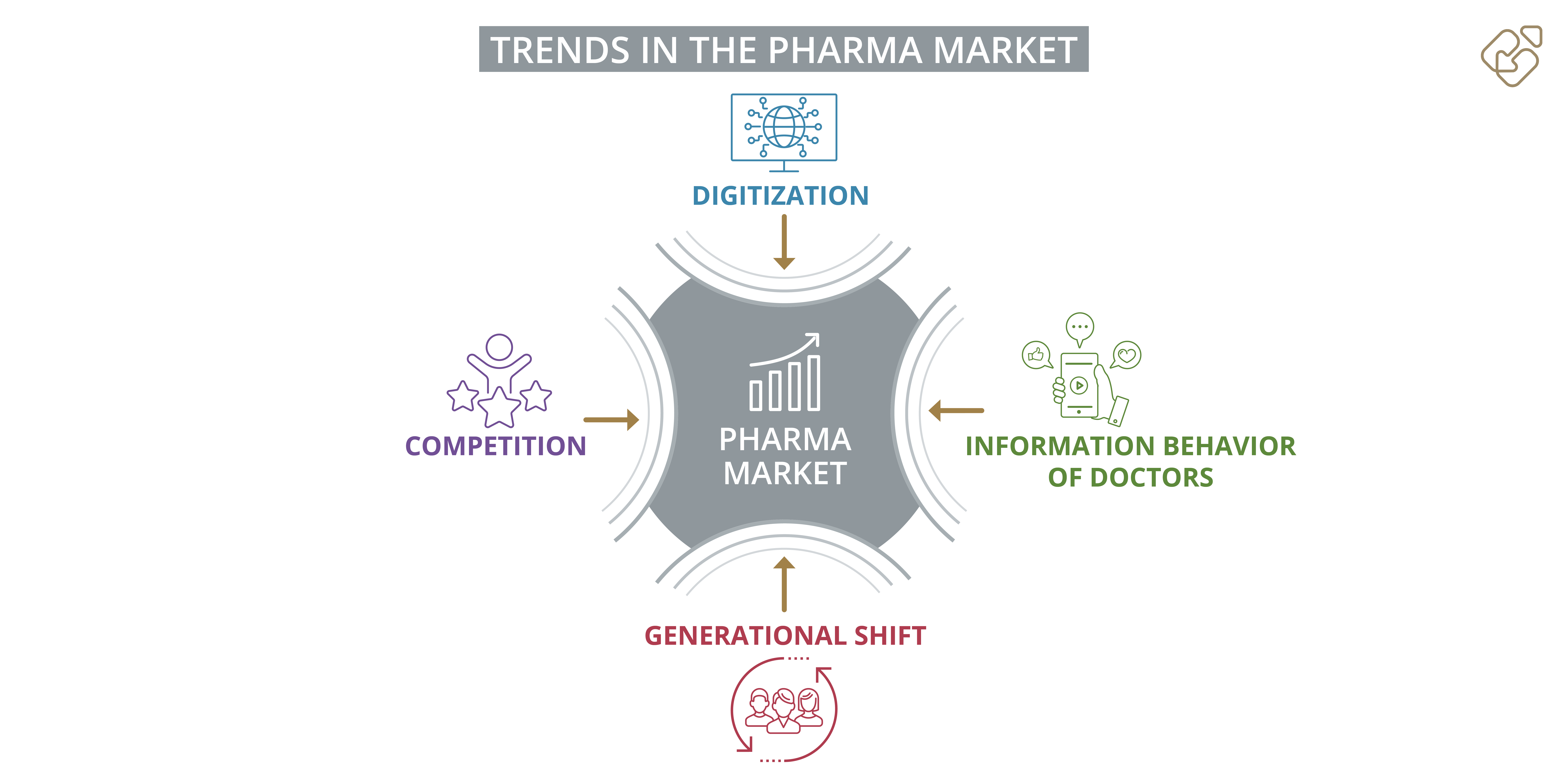
1. Digitization
While "digitization" may seem worn-out due to its frequent use, its impact is tangible, particularly in marketing and sales, through the following two aspects:
- Firstly, there has been a significant expansion in the range of available channels. Online platforms such as search engines (e.g., Google), social networks (e.g., Facebook and LinkedIn), physician platforms (e.g., Medscape), and medical content websites (e.g., MedPage Today or The BMJ) offer entirely new opportunities to engage with the target group. Additionally, traditional sales channels are seeing the emergence of digital alternatives (e.g., video calls instead of in-person visits, webinars instead of seminars, e-detailing instead of sales presentations). Pharmaceutical companies now face the challenge of effectively utilizing these channels and platforms to reach their target group through their preferred mediums. As the number of channels within the customer journey continues to grow, having a consistent omnichannel strategy becomes increasingly crucial.
- Secondly, digitization has significantly enforced the role of data in pharmaceutical sales and marketing. Digital channels, in particular, benefit from data generated through interactions with the target group (e.g., clicks, views, etc.), offering valuable insights into their responses. As a result, it is becoming increasingly important for pharmaceutical companies to effectively process and use this data to actively manage and personalize communications across digital and offline channels. Coordinating the different channels during the customer journey becomes a critical aspect, leading many companies to adopt more complex CRM systems that capture and process data systematically. This data-driven approach not only optimizes the linking of sales and marketing activities but also allows intelligent segmentation of target groups and the implementation of automated marketing sequences. Moreover, this data enables a sharper customer focus, utilizing insights from customer interactions to develop detailed customer profiles, and tailoring future interactions to their needs. In conclusion, omnichannel marketing provides pharmaceutical companies with a strategic framework to gradually develop customer-centric and data-driven sales and marketing communications.
2. Information Behavior of Physicians
Digitization also influences the way physicians seek information, which is evident on two levels:
- Firstly, physicians increasingly favor online sources for information, and the internet, especially Google, has become a central point of contact for their questions and research. Over three-quarters of physicians in Germany now integrate online research into their daily work routine¹. Social networks like LinkedIn and medical platforms such as Medscape and MedPage Today are also increasingly vital for physicians to access medical information and engage with colleagues and Key Opinion Leaders (KOLs). Consequently, digital channels become an essential component in omnichannel pharma marketing, especially for younger physicians who are particularly adept in the digital world.
- Secondly, physicians' expectations regarding relevant content have evolved with digitization. While the quality of content remains important, the ability to access it on-demand, personalize it, and make it digitally accessible is becoming increasingly significant. Market leaders like Google, YouTube, Netflix, and Meta (Facebook) continuously set new standards for information availability (anytime, anywhere, on any device, in the desired format) and content personalization (e.g., personalized news feeds or individualized video suggestions). As the majority of physicians are now digital natives², pharmaceutical companies must adapt to their high expectations regarding information options and communication. Generic sales information curated by the sales force will no longer suffice in the future. Instead, pharmaceutical companies must adopt an omnichannel approach that reaches customers across all relevant channels and tailors communications to their specific needs.
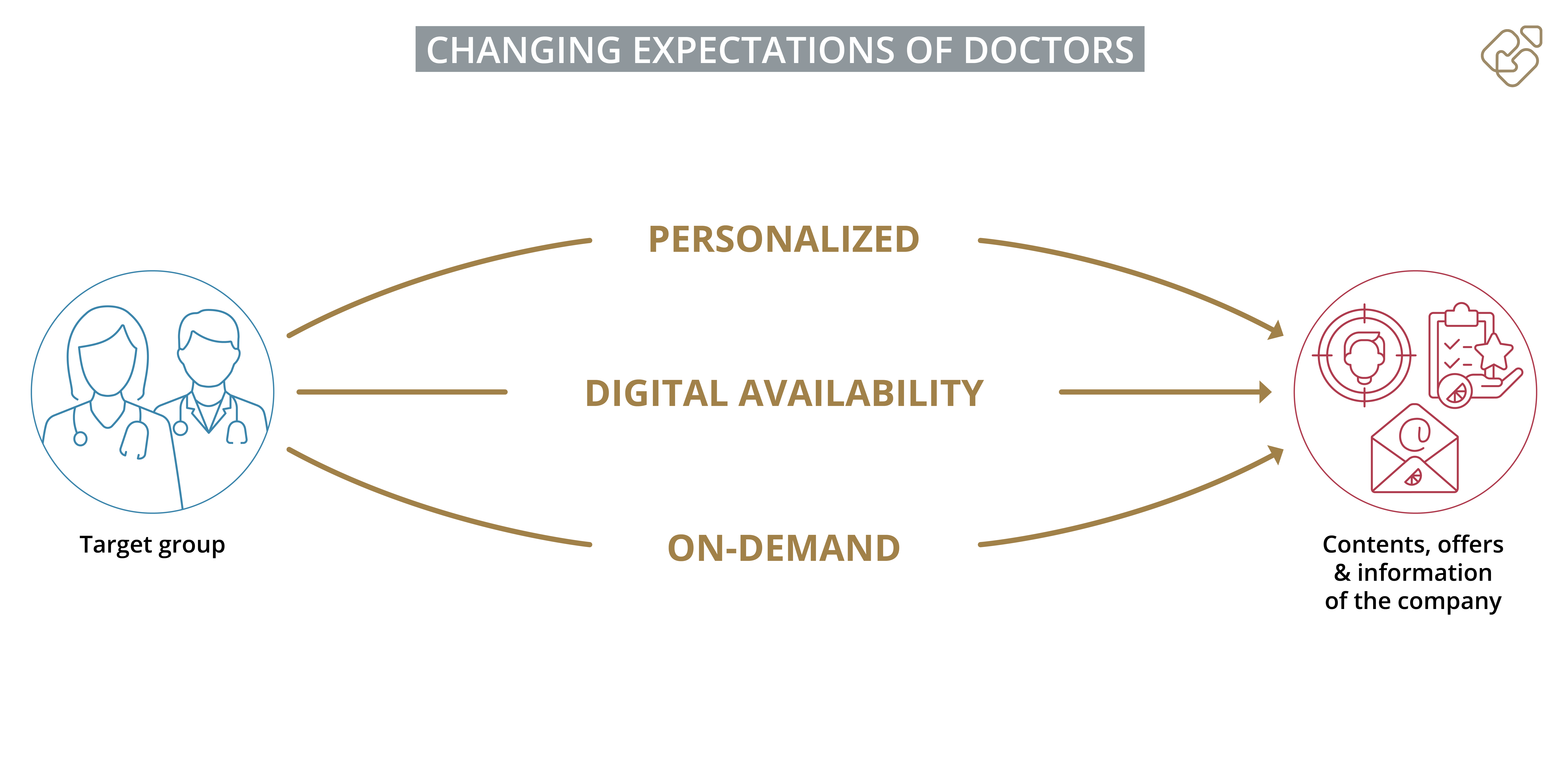
3. Competition
The growing role of digital channels brings about another challenge – competitive pressure. Easy access to digital channels means a substantial increase in competition for physicians' attention, occurring on several levels:
- The first level is direct competition, where pharmaceutical companies vie for physicians' attention alongside their direct competitors in the pharma market through the same digital channels. Consequently, every piece of content, message, and campaign competes with numerous other pharmaceutical companies attempting to reach physicians online.
- The second level entails indirect competition, with pharmaceutical companies facing competition from various players in the healthcare market beyond direct competitors. This includes MedTech companies, software and service providers, and organizers of medical events and congresses—all competing for the attention of medical decision-makers.
- Lastly, pharmaceutical companies must contend with the overwhelming volume of non-medical content, advertisements, news, and offers that physicians receive daily. Physicians, who are regular customers, users, or followers of numerous companies and content creators, are consistently bombarded with information.
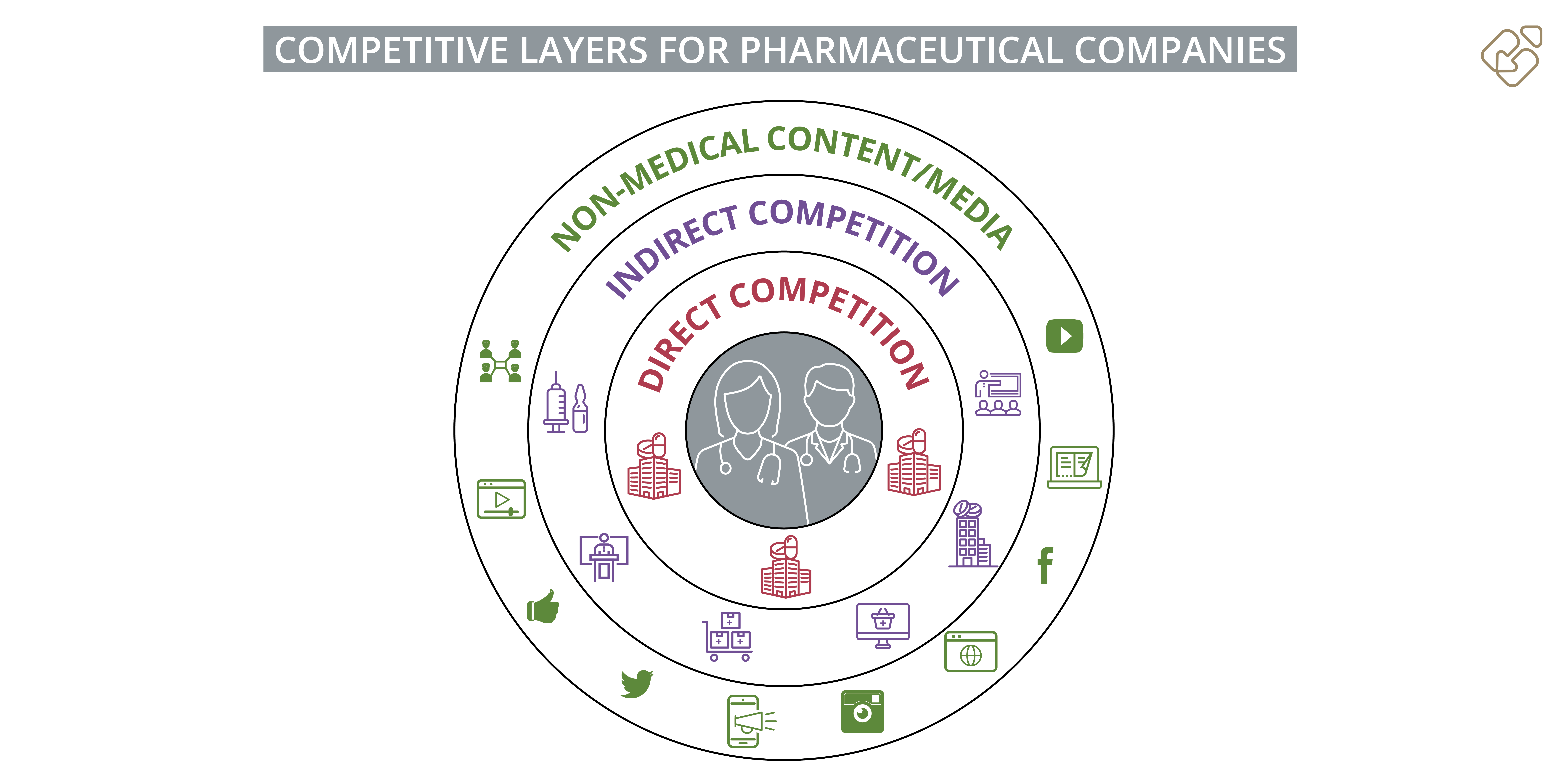
Taken together, these three levels create an overwhelming deluge of content and offers demanding physicians' attention. Simultaneously, physicians' availability is decreasing due to increased time pressures and reduced willingness to engage in sales visits. Consequently, competition for physicians' attention intensifies, while their attention spans decrease at the same time. To effectively reach physicians with relevant messages, the key factors of relevance and timing become crucial. Omnichannel pharma marketing, as a strategic framework, empowers pharmaceutical companies to specifically target physicians with the right content, at the right time, and through the right channels.
4. Generational Change
Another critical factor closely intertwined with the aforementioned trends is generational change. While changes in information acquisition and the importance of digitization are relevant for all physicians, they have a particularly significant impact on the younger generation. Currently, over half of physicians consider themselves digital natives², with digital communication and information channels deeply integrated into their daily lives. As such, they no longer perceive personalized content or on-demand access to information as exciting innovations but rather as standard practices in their digital world.
The generational shift ensures that the pace of change in the pharmaceutical market will continue to accelerate in the coming years, with the aforementioned trends becoming even more noticeable. It is crucial for pharmaceutical companies to strategically adopt omnichannel pharma marketing at this juncture to sharpen their customer focus and align with the needs and expectations of the new generations.
In summary, these four interconnected trends are the driving forces shaping the future of the pharmaceutical market over the next few years. Their profound impact necessitates a shift from merely adjusting individual elements in sales and marketing to implementing organization-wide solutions that equip companies to thrive in the challenges of a digital pharmaceutical market. Omnichannel pharma marketing, with its holistic approach, therefore holds enormous potential to address these evolving trends effectively.
How does Omnichannel Pharma Marketing work?
After the initial introduction to omnichannel pharma marketing, which includes its main principles (customer centricity, customer journey, customer insights), and an exploration of the trends that make this approach particularly relevant for the pharma market (digitization, information behavior of physicians, competition, generational change), the subsequent series of articles will delve into the practical aspects of implementing omnichannel pharma marketing. We will closely examine the three fundamental building blocks of the omnichannel approach and demonstrate how they collectively form the foundation of successful omnichannel pharma marketing:

1. Customer Journey in Omnichannel Pharma Marketing
Having already discussed the role of the customer journey as a central principle behind omnichannel pharma marketing in the first part, this article now focuses on the practical function of the customer journey as the core building block of the omnichannel approach. We will explore the essential elements of the customer journey, such as segmentation, decision phases, and sequences, and elucidate how each of these components contributes to the overall effectiveness of the approach.
2. The Channels in Omnichannel Pharma Marketing
Building upon the concept of the customer journey, the subsequent article provides an overview of the most crucial channels in omnichannel pharma marketing. We differentiate between their function as either push or pull channels, i.e., whether they are used for actively reaching the target audience or for engaging medical decision-makers when they seek information. Furthermore, we present the significance of a content hub and how it facilitates the exchange of data and content across the various channels.
3. Data Management in Omnichannel Pharma Marketing
In the final part of this series, we delve into data management in omnichannel pharma marketing. This article aims to understand how data can be effectively utilized to drive pharmaceutical sales and marketing strategies. We address three essential questions:
1. What data is relevant in omnichannel pharma marketing?
2. How should this data be processed to aid pharmaceutical companies in making informed decisions?
3. What role does selecting the right data infrastructure play in the successful capture, processing, and utilization of data?
What Impact Does Omnichannel Pharma Marketing Have on the Success of Pharmaceutical Companies?
With its comprehensive approach, omnichannel pharma marketing profoundly influences the orientation of pharmaceutical companies. Having explored what omnichannel pharma marketing is and how it operates in the preceding sections, we now examine the impact of this approach and the benefits it offers to pharma companies. This examination involves the following stages:

The Foundation - the Advantages of Omnichannel Pharma Marketing
The advantages form the foundation for success in omnichannel pharma marketing. They encompass the most crucial changes that pharmaceutical companies can leverage to gain significant benefits and position themselves for future success. The advantages include the essential factors – from customer centricity to targeted digitization – that contribute to the company's enduring success. In the following article, we explore the top five advantages of employing omnichannel strategies in pharma marketing.
Having looked at the success behind omnichannel pharma marketing in the article "The Advantages of Omnichannel Pharma Marketing", let's now take a closer look at how that success manifests itself at the three most important levels of the business:
Level 1: Effects of Omnichannel Pharma Marketing at the Divisional Level
The first level focuses on the effects that the omnichannel approach has on marketing and sales in pharmaceutical companies, respectively:
A) Effects of Omnichannel Pharma Marketing on Pharma Marketing
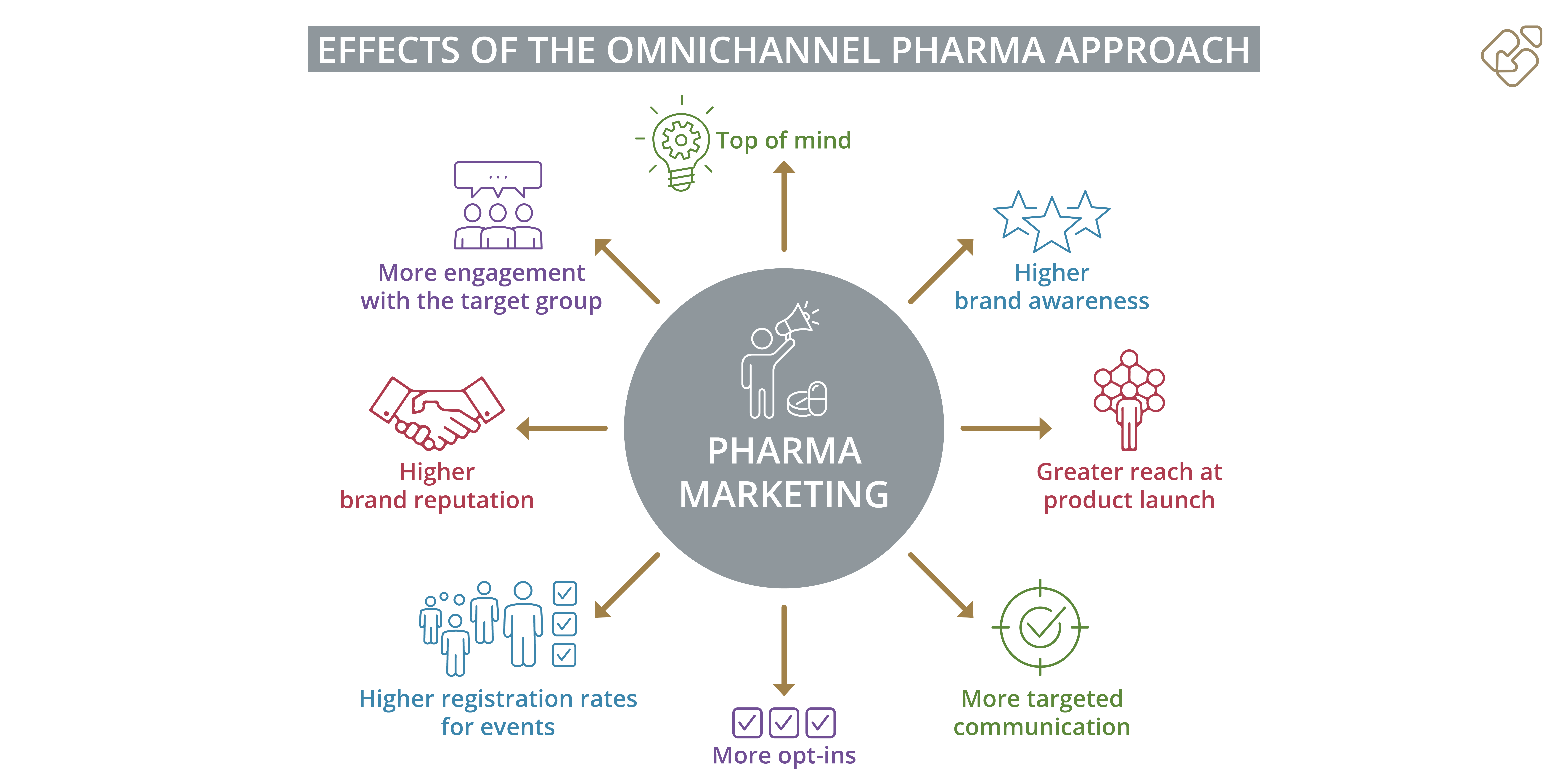
More Opt-ins
Especially for communication on digital channels (e.g., email), obtaining consent from physicians can be a challenge. Omnichannel pharma marketing offers two key advantages in this regard. Firstly, the increased customer focus motivates physicians with highly relevant content and added value to opt-in. Secondly, the customer journey includes targeted and coordinated contact points for lead generation that actively encourage physicians to opt in. Various contact points are deliberately linked to continuously guide physicians toward their opt-in.
Higher Registration Rates for Events
Omnichannel pharma marketing allows companies to gain more opt-ins and generate increased registrations for their events (e.g., webinars, and training courses). The tailored customer approach and cross-channel sequences play a crucial role in marketing events more effectively.
More Engagement of the Target Group
Relevance plays a critical role in enhancing the effectiveness of interactions with the target group. The more relevant a company's marketing content and measures are perceived to be, the more attention physicians will pay to them. Thus, customer focus in omnichannel pharma marketing provides a decisive foundation for more effective interactions with the target group.
Higher Brand Awareness
To be remembered by the target group with new or lesser-known brands and products (e.g., during product launches), pharmaceutical companies need consistency. Omnichannel pharma marketing reinforces brand awareness through three key advantages:
- Customer Centricity: By focusing specifically on the needs of physicians, pharmaceutical companies can communicate in a more relevant manner, thereby increasing the effectiveness of their interactions with the target audience.
- Utilizing Synergies: Well-coordinated sequences within the customer journey link different channels more closely allowing companies to create synergy between them.
- Unified Communication: The cross-divisional approach in omnichannel pharma marketing helps pharmaceutical companies align their messages on different channels. This creates a unified image with a clear brand message from the physicians' perspective.
- Customer Centricity: By focusing specifically on the needs of physicians, pharmaceutical companies can communicate in a more relevant manner, thereby increasing the effectiveness of their interactions with the target audience.
Higher Brand Trust
Brand trust determines the extent to which physicians will interact with the company and be convinced by its products. Omnichannel pharma marketing offers three important advantages in building brand trust:
- Recognizing Needs: Understanding customer needs and responding to them demonstrates trustworthiness. The omnichannel pharma approach emphasizes gathering customer information to position companies as trustworthy problem solvers.
- Creating Added Value: Providing physicians with tangible added value that aligns with their needs and interests fosters trust. Omnichannel marketing's cross-functionality helps identify target group problems and offer relevant content, such as webinars tailored to identified needs.
- Personalization: Omnichannel pharma marketing translates acquired customer insights into personalized actions and content that specifically cater to the needs of individual physicians.
- Recognizing Needs: Understanding customer needs and responding to them demonstrates trustworthiness. The omnichannel pharma approach emphasizes gathering customer information to position companies as trustworthy problem solvers.
Top of Mind
"Top of mind" is a key goal in pharma marketing - positioning one's brand as the first association with certain medical topics (e.g., headache à aspirin) in the minds of customers. Increased brand awareness and brand trust in omnichannel pharma marketing are essential prerequisites for achieving this position.
Greater Reach for Product Launch
Omnichannel pharma marketing is an important tool for optimizing marketing power when launching new products. From needs identification and understanding the target group to finely tuned marketing sequences and personalized content, omnichannel marketing expands the potential of sales in the healthcare market.
Transparency in the Success of Actions
Omnichannel pharma marketing not only tailors communication to the needs of physicians but also measures what resonates with the target group. This creates a reinforcing feedback loop that continuously optimizes marketing communications and makes the success of actions more transparent for evaluation.
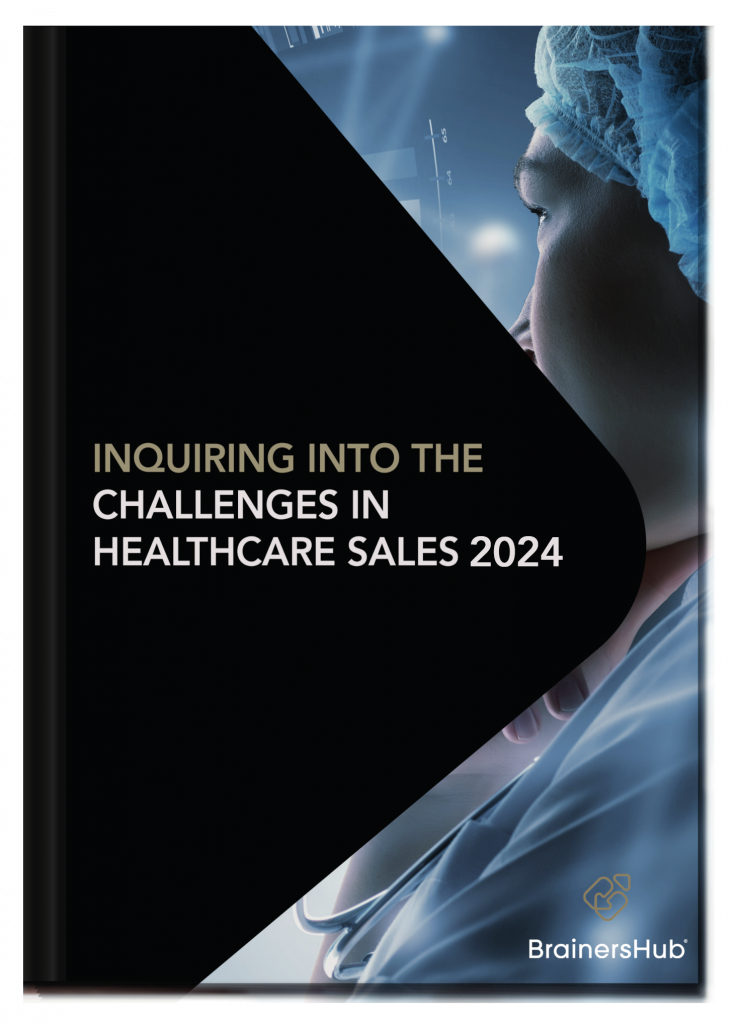
Free whitepaper
Challenges in Healthcare Sales 2024
- The biggest Challenges in Healthcare Sales 2024
- The hottest Trends in Healthcare Marketing
- What Sales Experts Wish For
B) Effects of Omnichannel Pharma Marketing on Pharmaceutical Sales
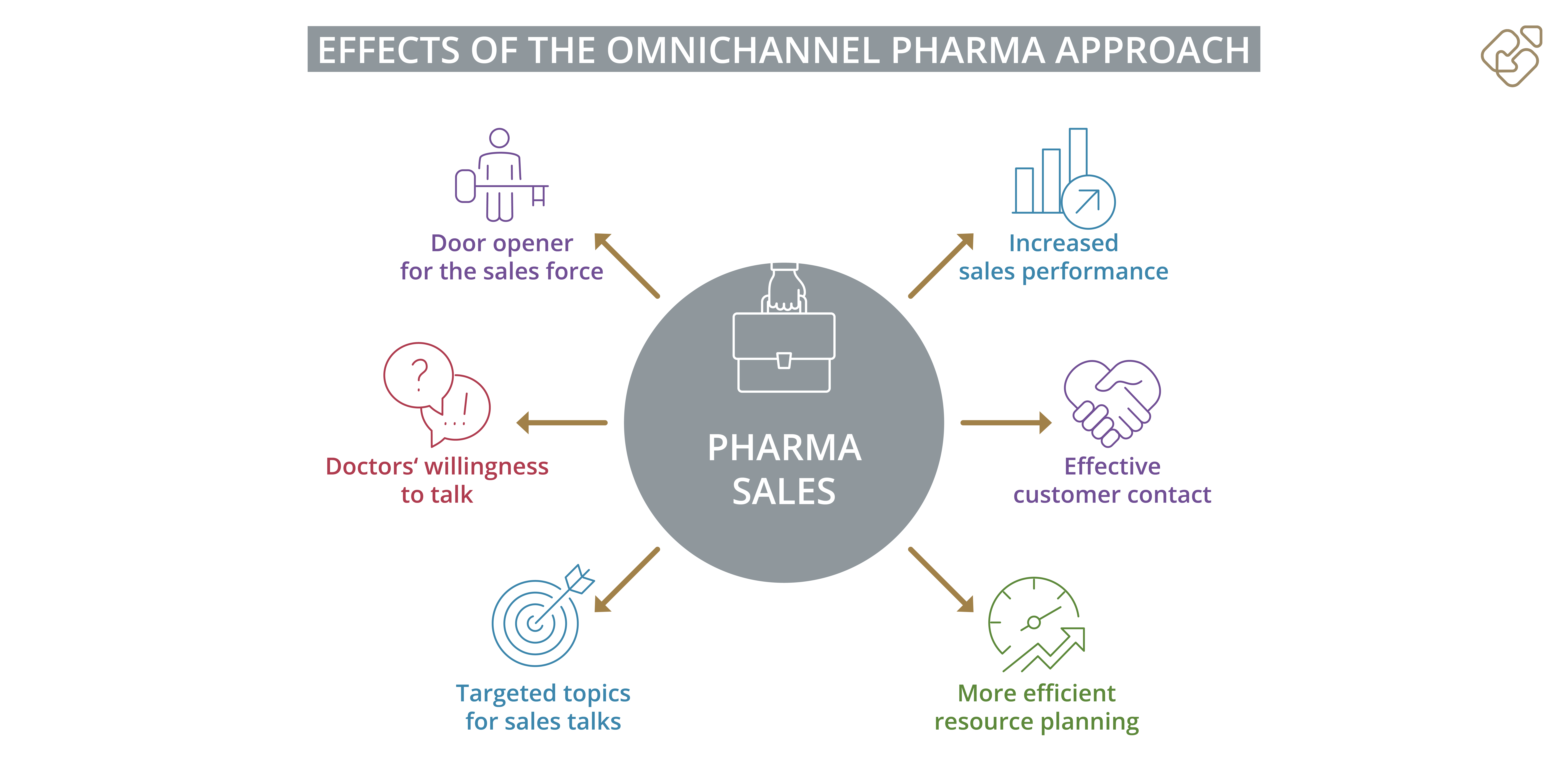
Door Opener for the Sales Force
The successes in pharmaceutical marketing described earlier, such as increased brand trust or positioning one's own solutions as top of mind, offer important door openers for pharmaceutical sales. The sales force benefits significantly from the linking of various business units throughout the customer journey. The more sales and marketing activities are coordinated the more the field force will capitalise on the information, contacts, and increased brand awareness created by previous marketing measures. Especially since familiarity and trust in the brand increase physicians' willingness to engage with sales representatives.
Targeted Topics for Sales Meetings
Pharmaceutical sales also benefit from the door-opening function of the omnichannel approach in the form of detailed customer information. Insights from marketing activities help sales better understand the needs and interests of physicians, enabling them to tailor sales materials (e.g. slides in a sales presentation, suitable training, and seminars) and interactions (e.g. referring to a study previously read by the physician) more effectively. This personalization enhances the sales offer instead of using standard messages.
Effective Customer Contact
Success in pharmaceutical sales hinges on the capacity to engage customers effectively. Comprehensive insights into customer needs and topics, delivered through omnichannel pharma marketing, greatly empower sales representatives. Digital strategies, in particular, offer the chance to bolster external activities with precise content, further enhancing customer interactions. Embracing omnichannel pharma marketing is a pivotal move to unlock the full potential of sales efforts.
Willingness to Talk Among Physicians
The omnichannel approach empowers pharmaceutical companies to share the burden of sales with other areas of responsibility. Leveraging digital offerings and content marketing allows companies to reach doctors early in their decision-making process with personalized content. This serves as a springboard for sales, making it easier to initiate conversations. Marketing initiatives that spark interest and encourage conversation play a vital role in supporting sales staff.
More Efficient Resource Planning
Beyond boosting the effectiveness of sales leads, omnichannel pharma marketing also contributes to increased efficiency. By embracing measurability, pharmaceutical companies can strategically allocate their resources, such as the sales force, to where they are most needed, targeting physicians with the highest potential.
Increased Sales Performance
Combined, these advantages provide sales teams with valuable opportunities to enhance their performance, even with an unchanged or reduced sales force. Collaboration between marketing and sales, coupled with a heightened customer focus in omnichannel pharma marketing, thus generates significant benefits for sales efforts.
Level 2: Effects of Omnichannel Pharma Marketing on the Customer Relationship
The effectiveness of omnichannel pharma marketing is rooted in its capacity to enhance relationships between pharmaceutical companies and their target audiences. By establishing a structured foundation in sales and marketing, pharmaceutical companies can proactively nurture customer relationships. This customer-centric approach becomes a driving force behind the competitiveness of pharmaceutical companies, facilitating focused market penetration, differentiation from competitors, and the expansion of market share.
In this section, we explore the specific effects of omnichannel pharma marketing on the customer relationship. These effects can be likened to layers of an onion. At its core, the goal is to gain the target group's trust. However, to achieve this, pharmaceutical companies must work through four more layers:
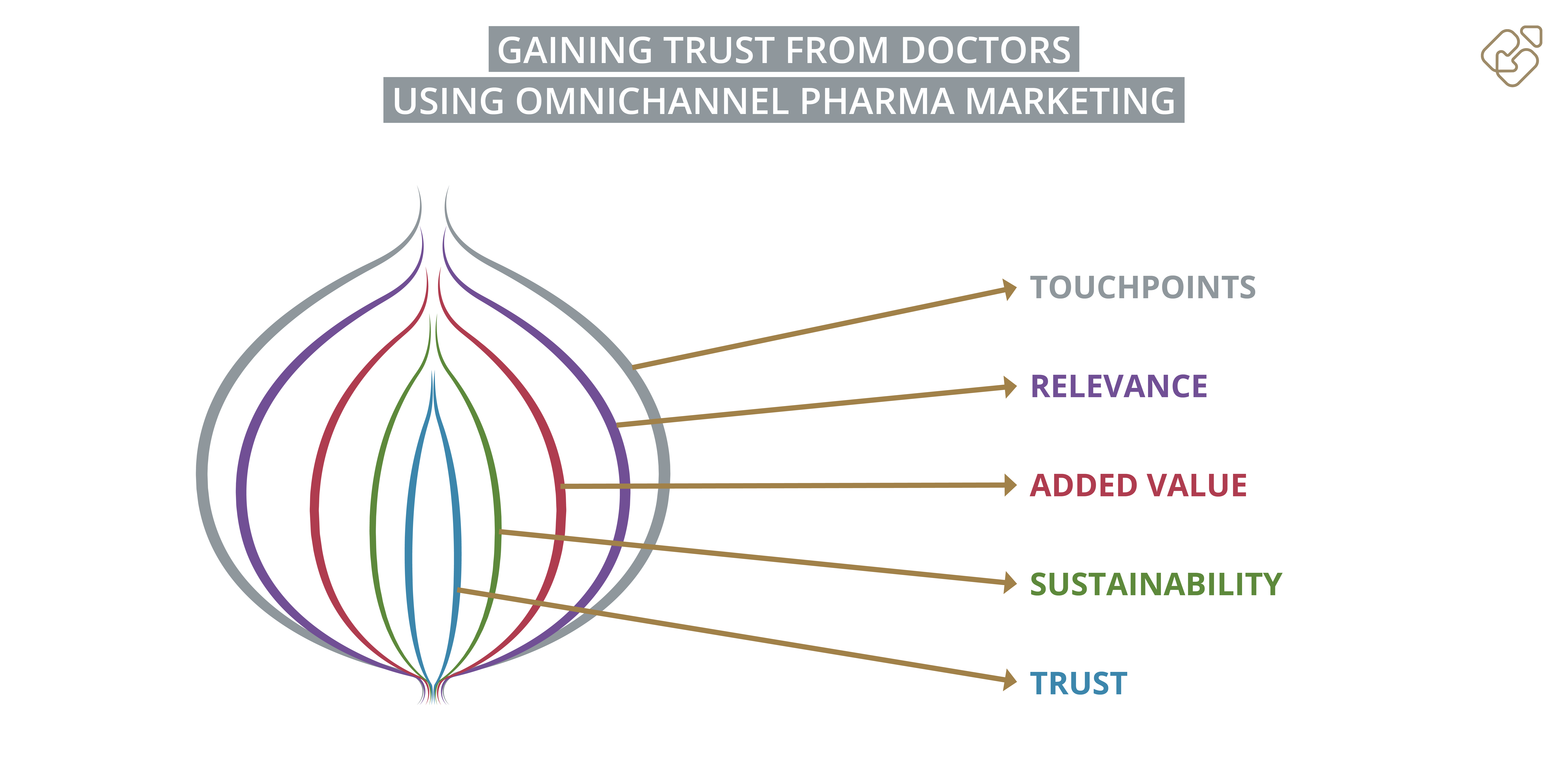
Touchpoints
At its outermost layer, omnichannel marketing allows for an increase in both the number and variety of touchpoints with the target audience:
- Amount: Digital channels play a crucial role in increasing the number of touchpoints by expanding the opportunities to engage with physicians. For example, reaching physicians during their online research on platforms like Google or supplementing traditional measures with additional digital content related to sales conversations.
- Diversity: Omnichannel marketing introduces new channels that offer diverse formats for addressing physicians. From videos, podcasts, and social media posts in marketing to interactive presentations (e.g., e-detailings), webinars, and video calls in sales.
Relevance
While having a high number of touchpoints is important, the effectiveness of each touchpoint depends on tailoring it to the specific needs of the individual doctor.
- Customer Focus: Relevant communication requires an in-depth understanding of the target group and its topics and needs. This is precisely why omnichannel pharma marketing places significant emphasis on collecting all feedback, data, and responses from the target group and leveraging them to make strategic decisions (such as selecting topics, defining formats, and choosing suitable measures). This approach enables the ongoing refinement of customer profiles and the continual fine-tuning of interactions with doctors.
- Modern Information Behavior: Adapting to trends in information behavior (see: Information Behavior of Physicians) is crucial for both pharma sales and marketing. Younger physicians, in particular, value personalization, online availability, and on-demand access. To meet these preferences omnichannel marketing integrates digital channels and formats into the communication.
Value Added
While exciting and relevant content is an effective door opener for the exchange with physicians, it is important to subsequently provide customers with concrete added value. The goal is to convert physicians' interests into opportunities to actively show how the company can help them with their challenges.
- Information: Valuable added can take the form of well-researched, tailored information (e.g., studies, continuing education, patient information brochures). Events like webinars, conferences, and training courses also play a crucial role in facilitating content-related and personal exchanges with colleagues and experts.
- Beyond the Pill: To stand out from the competition, pharmaceutical companies are developing innovative solutions that create added value around their products. These solutions may support patients in adhering to therapies or enhance therapy success with accompanying measures. Success in delivering these value-added services hinges on a deep understanding of the target audience, enabling a tailored approach to meet the specific needs of physicians (see: Customer Centricity).
Sustainability
This point focuses on the long-term development of customer relationships. For pharmaceutical companies, this means that interactions, relevance, and added values have to be confirmed repeatedly to strengthen their connections with physicians. For this purpose, the Customer Journey plays a decisive role in omnichannel pharmaceutical marketing. It is designed to continuously strengthen the customer relationship by utilizing targeted touchpoints informed by insights and experiences gathered during each interaction. This approach seeks to strike a balance between proven measures and new impulses.
At the same time, the dialogue envisioned in omnichannel pharma marketing thrives in this context. Beyond conveying the company's messages, the customer relationship is built on attentively listening to and actively addressing physicians' expressed needs and feedback. This way, pharmaceutical companies can show their customers the importance they attach to their relationship and that they are prepared to invest in it on an ongoing basis.
By combining these four levels, omnichannel pharma marketing lays the foundation for winning the trust of physicians and establishing long-term relationships with them. Pharmaceutical companies are moving beyond merely promoting their products and are increasingly becoming vital contacts and problem solvers for physicians, wielding valuable influence over their decision-making.
In the next step, we want to explore how pharmaceutical companies can leverage this foundation to expand their business success:
Level 3: Effects of Omnichannel Pharma Marketing on Company Success
The impact of the omnichannel approach on the success of pharmaceutical companies can best be illustrated through a value chain that begins with customer engagement and culminates in future viability:
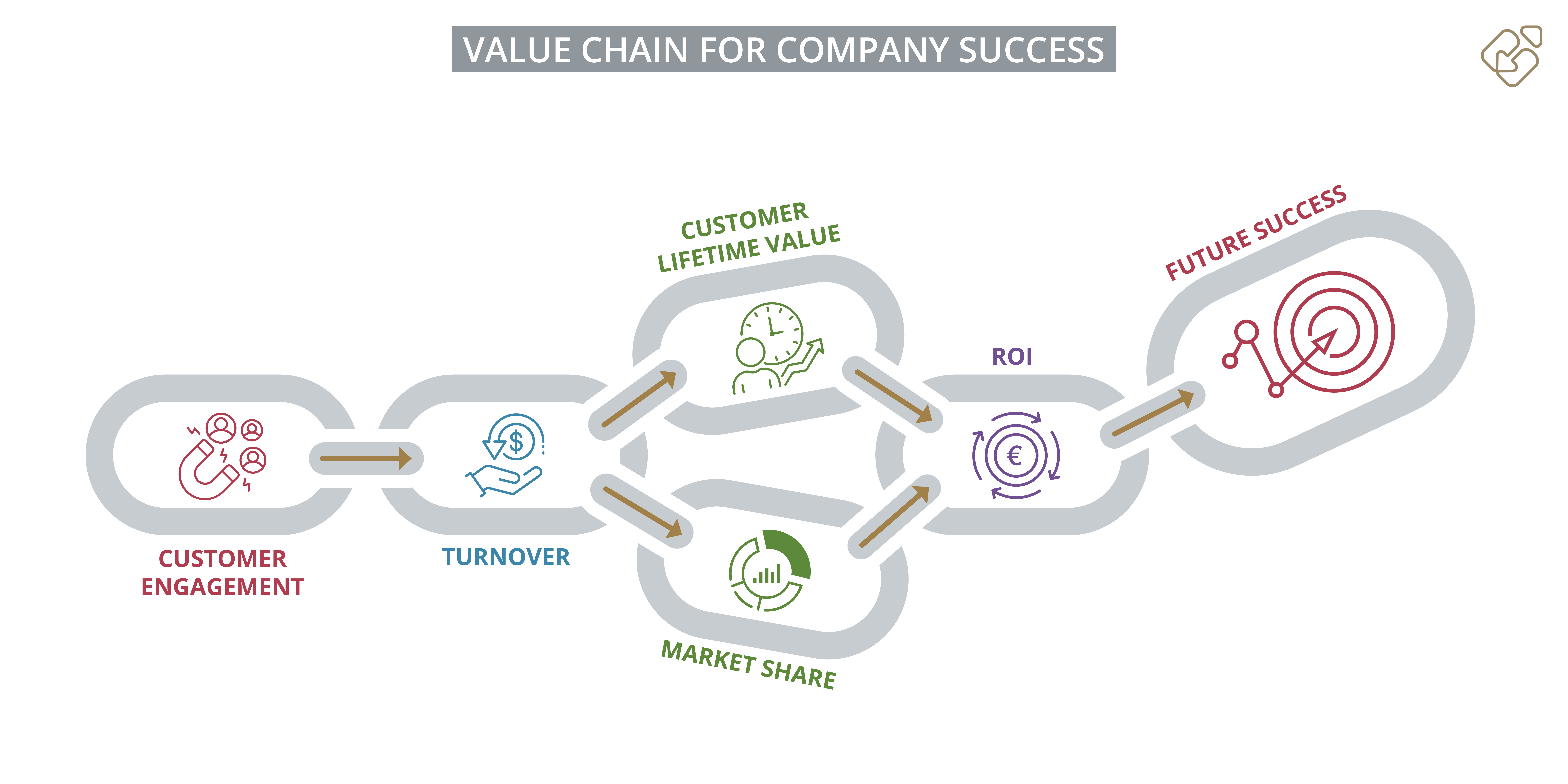
Strengthen Customer Engagement
Challenge: Customer engagement refers to the ability of pharmaceutical companies to motivate physicians to interact and respond measurably. In marketing, this involves achieving key figures such as website visits, content views, or generated opt-ins. In sales, factors like call time, willingness to talk during on-site sales force visits, or event and seminar participation count.
Effect: The significant impact of omnichannel pharma marketing on the effectiveness of marketing and sales, as well as customer relationships, makes it a crucial driver for customer engagement. By leveraging the versatile strengths of the omnichannel approach, such as delivering relevant sales and marketing content, personalized targeting, and digital dialog, pharmaceutical companies improve their effectiveness in engaging with physicians and influencing their decision-making.
Increased Sales
Challenge: The next element in the value chain revolves around the ability of pharmaceutical companies to translate customer engagement into increased prescriptions and sales. This primarily involves identifying physicians and facilities with high potential and effectively supporting them in their decision-making process.
Effect: The omnichannel approach contributes to increased sales performance through various sales-promoting factors:
- Data-driven identification of high-potential target groups.
- Optimized targeting of the audience with detailed customer insights.
- Increased contact frequency by combining digital and in-person touchpoints.
- Enhanced contact effectiveness through data-optimized marketing and sales content.
- Improved brand awareness and trust.
- Customer-oriented product development, prioritizing Customer Centricity.
- More targeted influence on physician decision-making through individualized customer journeys.
Together, these factors provide effective leverage for influencing physicians' decisions through omnichannel pharma marketing, resulting in increased company sales.
Extend Customer Lifetime Value
Challenge: In the pharmaceutical market, sustainability is paramount. This extends beyond merely achieving short-term increases in sales and requires an investment in long-term customer relationships with physicians. This way, pharmaceutical companies create the basis for profiting continuously from their original sales and marketing efforts when doctors become loyal customers who trust the company's products for years resulting in sustained prescription levels.
Effect: Omnichannel pharma marketing places a strong emphasis on continually investing in relationship building. Getting to know doctors and medical decision-makers better, even after the first prescriptions, enables companies to address their individual needs and challenges more effectively. Based on this customer relationship cultivated over many years, pharmaceutical companies can foster stronger bonds with physicians, profiting sustainably from their potential. Additionally, a loyal customer base can support new product launches and the acquisition of Key Opinion Leaders (KOLs).
Gain Market Share
Challenge: Competition among pharmaceutical companies is fierce. To succeed, companies must consolidate their position in the market and gain and defend new market shares. Differentiating the company clearly from competitors and offering relevant added value to the target group is therefore crucial.
Effect: The omnichannel approach in pharma focuses on the customer relationship as a key differentiator. This fosters valuable competitive resources such as brand trust, a personal bond between doctors and the company, and a deep understanding of the target group. These resources form a sustainable basis for establishing new products in the market and increasing market penetration for existing ones.
Improve ROI
Challenge: ROI serves as a key metric for measuring profitability. It compares outputs (return) with inputs (investment) to determine how efficiently pharmaceutical companies use their resources.
Effect: Omnichannel pharma marketing significantly impacts corporate profitability as its effects extend to both sides of the ROI equation. On one hand, factors like increased sales, customer lifetime value, and market share help boost the return. On the other hand, the omnichannel approach optimizes the efficiency of resource utilization through data-driven decisions, evaluation of actions, and customer prioritization. Additionally, the stronger linkage of channels creates new synergies, increasing the effectiveness of touchpoints with physicians.
Omnichannel pharma marketing, therefore, improves the profitability of pharmaceutical companies on both ends simultaneously – enhancing sales and marketing output while optimizing the efficiency of the resources used in this process.
Create Future Viability
Challenge: Success is fleeting, and pharmaceutical companies must lay the groundwork in advance to remain competitive in the face of future challenges.
Effect: Omnichannel pharma marketing equips organizations with suitable answers to the most important trends in the healthcare market, setting a course for future development. Additionally, this approach fosters a self-reinforcing feedback mechanism that encourages learning from current projects. Cultivating a mindset that values collaboration between teams, intensifies customer relationships, and develops new insights, best practices, and competencies ensures sustainable growth over the long term.
By embracing omnichannel pharma marketing, companies create a strong foundation for building lasting trust with the target group and establishing mutually beneficial long-term relationships. As pharmaceutical companies evolve from merely promoting products to becoming essential contacts and problem solvers for physicians, they gain significant influence over their decision-making. This approach allows them to enhance their positioning and build essential resources towards continued success in the future.
EXPERT
Nicole Ehrhardt – Partner & Business Director

Erfolgreiches Projektmanagement mit und ohne Projektmanagement Beratung
Projektmanagement als Schlüssel zu langfristigen Erfolg: ✔️ Effiziente Ressourcenallokation ✔️Risiken minimieren ✔️Strategischen Ziele sichern

The Advantages of Omnichannel Pharma Marketing
Learn about the advantages of Omnichannel Pharma Marketing and how your company can benefit from them:
✔️ Customer centricity
✔️ Breaking down information silos
✔️ Cross-functional cooperation
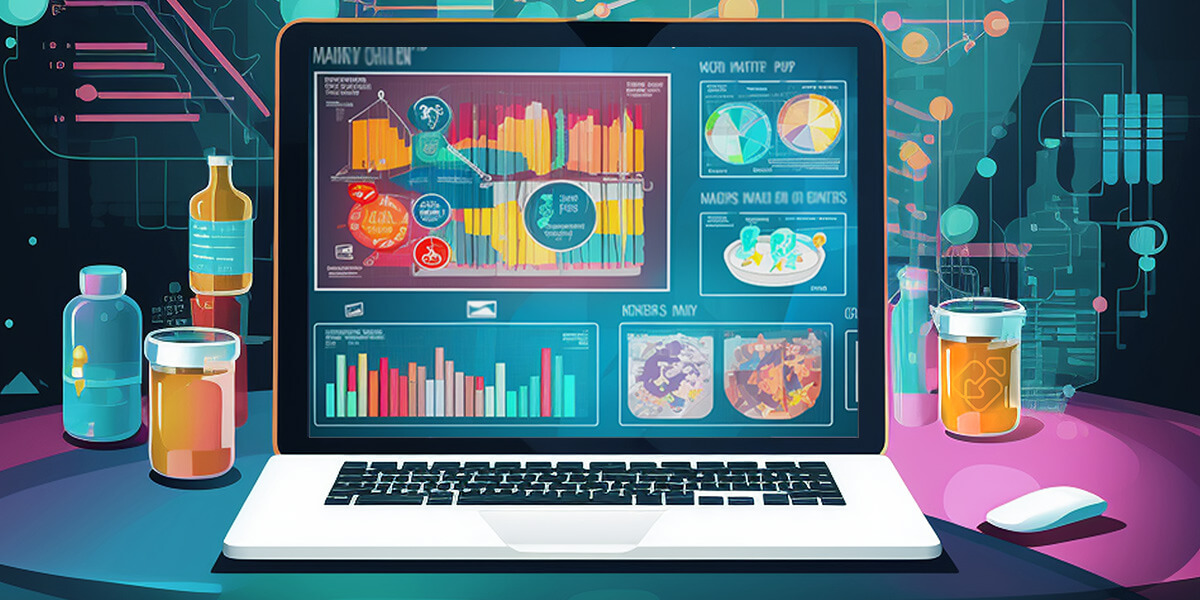
Understanding Data Management in Omnichannel Pharma Marketing
Learn how data management works in Omnichannel Pharma Marketing and how pharma sales and marketing can benefit from it:
✔️ Data processing
✔️ Data infrastructure
✔️ Using data in practice
Sources:
1. healthrelations.de, 2016
2. coliquio-insights.de, 2015


